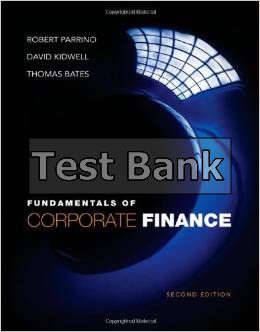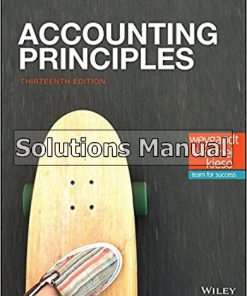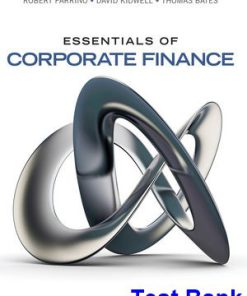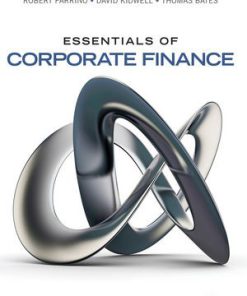Fundamentals of Corporate Finance 2nd Edition Parrino Test Bank
$26.99$50.00 (-46%)
Fundamentals of Corporate Finance 2nd Edition Parrino Test Bank.
You may also like
Instant download Fundamentals of Corporate Finance 2nd Edition Parrino Test Bank pdf docx epub after payment.

Product details:
- ISBN-10 : 0470933267
- ISBN-13 : 978-0470933268
- Author:
Fundamentals of Corporate Finance, 2nd Edition offers an innovative integration of conceptual understanding and problem-solving… of intuition and decision-making… of the authors’ industry and classroom/research experience…with current real-world examples and online practice. Authors Robert Parrino, David Kidwell, and Thomas Bates believe that students who understand the intuition underlying the basic concepts of finance are better able to develop the critical judgments necessary to apply financial tools in real decision- making situations. Their text develops intuitive thinking while simultaneously helping students develop problem solving and computational skills. It then shows students how to apply intuition and analytical skills to decision making while integrating it all with valuation and building shareholder value.
Table of contents:
Chapter 1 Introduction to Corporate Finance 1 1.1 Corporate Finance and the Financial Manager 2 What Is Corporate Finance? 2 The Financial Manager 2 Financial Management Decisions 2 Capital Budgeting 2 Capital Structure 3 Working Capital Management 4 Conclusion 4 1.2 Forms of Business Organization 4 Sole Proprietorship 5 Partnership 5 Corporation 6 A Corporation by Another Name . . . 7 1.3 The Goal of Financial Management 8 Possible Goals 8 The Goal of Financial Management 9 A More General Goal 9 1.4 The Agency Problem and Control of the Corporation 10 Agency Relationships 10 Management Goals 10 Do Managers Act in the Stockholders? Interests? 12 Managerial Compensation 12 Control of the Firm 13 Conclusion 14 Stakeholders 14 1.5 Financial Markets and the Corporation 14 Cash Flows to and from the Firm 14 Primary versus Secondary Markets 15 Primary Markets 15 Secondary Markets 16 1.6 Summary and Conclusions 17 Chapter 2 Financial Statements, Taxes, and Cash Flow 20 2.1 The Balance Sheet 21 Assets: The Left-Hand Side 21 Liabilities and Owners? Equity: The Right-Hand Side 21 >> Net Working Capital 22 Liquidity 23 Debt versus Equity 24 Market Value versus Book Value 24 2.2 The Income Statement 25 GAAP and the Income Statement 26 Noncash Items 27 Time and Costs 27 2.3 Taxes 29 Corporate Tax Rates 29 Average versus Marginal Tax Rates 29 2.4 Cash Flow 31 Cash Flow from Assets 32 Operating Cash Flow 32 Capital Spending 33 Change in Net Working Capital 33 Conclusion 34 A Note on "Free" Cash Flow 34 Cash Flow to Creditors and Stockholders 34 Cash Flow to Creditors 34 Cash Flow to Stockholders 35 An Example: Cash Flows for Dole Cola 36 Operating Cash Flow 36 Net Capital Spending 37 Change in NWC and Cash Flow from Assets 37 Cash Flow to Stockholders and Creditors 38 2.5 Summary and Conclusions 39 PART TWO Financial Statements and Long-Term Financial Planning Chapter 3 Working with Financial Statements 48 3.1 Cash Flow and Financial Statements: A Closer Look 49 Sources and Uses of Cash 49 The Statement of Cash Flows 51 3.2 Standardized Financial Statements 53 Common-Size Statements 53 Common-Size Balance Sheets 54 Common-Size Income Statements 54 Common-Size Statements of Cash Flows 55 Common?Base Year Financial Statements: Trend Analysis 55 Combined Common-Size and Base-Year Analysis 56 ros91593_fm.qxd 12/20/04 22:06 Page xxxiii 3.3 Ratio Analysis 56 Short-Term Solvency, or Liquidity, Measures 57 Current Ratio 58 The Quick (or Acid-Test) Ratio 59 Other Liquidity Ratios 59 Long-Term Solvency Measures 60 Total Debt Ratio 60 A Brief Digression: Total Capitalization versus Total Assets 61 Times Interest Earned 61 Cash Coverage 61 Asset Management, or Turnover, Measures 62 Inventory Turnover and Days? Sales in Inventory 62 Receivables Turnover and Days? Sales in Receivables 63 Asset Turnover Ratios 64 Profitability Measures 64 Profit Margin 65 Return on Assets 65 Return on Equity 65 Market Value Measures 66 Price-Earnings Ratio 66 Market-to-Book Ratio 67 Conclusion 68 3.4 The Du Pont Identity 68 A Closer Look at ROE 68 An Expanded Du Pont Analysis 70 3.5 Using Financial Statement Information 71 Why Evaluate Financial Statements? 72 Internal Uses 72 External Uses 72 Choosing a Benchmark 72 Time-Trend Analysis 72 Peer Group Analysis 73 Problems with Financial Statement Analysis 77 3.6 Summary and Conclusions 78 Chapter 4 Long-Term Financial Planning and Growth 90 4.1 What Is Financial Planning? 91 Growth as a Financial Management Goal 91 Dimensions of Financial Planning 92 What Can Planning Acccomplish? 93 Examining Interactions 93 Exploring Options 93 Avoiding Surprises 93 Ensuring Feasibility and Internal Consistency 93 Conclusion 94 4.2 Financial Planning Models: A First Look 94 A Financial Planning Model:The Ingredients 94 Sales Forecast 94 Pro Forma Statements 94 Asset Requirements 95 Financial Requirements 95 The Plug 95 Economic Assumptions 95 A Simple Financial Planning Model 95 4.3 The Percentage of Sales Approach 97 The Income Statement 97 The Balance Sheet 98 A Particular Scenario 99 An Alternative Scenario 100 4.4 External Financing and Growth 102 EFN and Growth 104 Financial Policy and Growth 106 The Internal Growth Rate 106 The Sustainable Growth Rate 107 Determinants of Growth 108 A Note on Sustainable Growth Rate Calculations 109 4.5 Some Caveats Regarding Financial Planning Models 111 4.6 Summary and Conclusions 111 PART THREE Valuation of Future Cash Flows Chapter 5 Introduction to Valuation: The Time Value of Money 124 5.1 Future Value and Compounding 125 Investing for a Single Period 125 Investing for More Than One Period 125 A Note on Compound Growth 131 5.2 Present Value and Discounting 132 The Single-Period Case 132 Present Values for Multiple Periods 133 5.3 More on Present and Future Values 136 Present versus Future Value 136 Determining the Discount Rate 137 Finding the Number of Periods 141 5.4 Summary and Conclusions 144 Chapter 6 Discounted Cash Flow Valuation 149 6.1 Future and Present Values of Multiple Cash Flows 150 Future Value with Multiple Cash Flows 150 Present Value with Multiple Cash Flows 153 A Note on Cash Flow Timing 156 6.2 Valuing Level Cash Flows: Annuities and Perpetuities 157 Present Value for Annuity Cash Flows 157 Annuity Tables 159 Finding the Payment 160 Finding the Rate 162 Future Value for Annuities 163 A Note on Annuities Due 164 Perpetuities 165 6.3 Comparing Rates:The Effect of Compounding 167 Effective Annual Rates and Compounding 167 Calculating and Comparing Effective Annual Rates 168 EARs and APRs 170 Taking It to the Limit: A Note on Continuous Compounding 171 6.4 Loan Types and Loan Amortization 172 Pure Discount Loans 172 Interest-Only Loans 173 Amortized Loans 173 6.5 Summary and Conclusions 178 Chapter 7 Interest Rates and Bond Valuation 192 7.1 Bonds and Bond Valuation 193 Bond Features and Prices 193 Bond Values and Yields 193 Interest Rate Risk 197 Finding the Yield to Maturity: More Trial and Error 198 7.2 More on Bond Features 203 Is It Debt or Equity? 203 Long-Term Debt: The Basics 203 The Indenture 205 Terms of a Bond 205 Security 206 Seniority 206 Repayment 206 The Call Provision 207 Protective Covenants 207 7.3 Bond Ratings 208 7.4 Some Different Types of Bonds 209 Government Bonds 209 Zero Coupon Bonds 210 Floating-Rate Bonds 211 Other Types of Bonds 212 7.5 Bond Markets 214 How Bonds Are Bought and Sold 214 Bond Price Reporting 216 A Note on Bond Price Quotes 219 7.6 Inflation and Interest Rates 219 Real versus Nominal Rates 219 The Fisher Effect 220 7.7 Determinants of Bond Yields 221 The Term Structure of Interest Rates 221 Bond Yields and the Yield Curve: Putting It All Together 223 Conclusion 225 7.8 Summary and Conclusions 226 Chapter 8 Stock Valuation 233 8.1 Common Stock Valuation 234 Cash Flows 234 Some Special Cases 236 Zero Growth 236 Constant Growth 236 Nonconstant Growth 239 Components of the Required Return 241 8.2 Some Features of Common and Preferred Stocks 243 Common Stock Features 243 Shareholder Rights 243 Proxy Voting 244 Classes of Stock 245 Other Rights 245 Dividends 245 Preferred Stock Features 246 Stated Value 246 Cumulative and Noncumulative Dividends 246 Is Preferred Stock Really Debt? 247 8.3 The Stock Markets 247 Dealers and Brokers 247 Organization of the NYSE 248 Members 248 Operations 249 Floor Activity 249 NASDAQ Operations 250 NASDAQ Participants 251 Stock Market Reporting 252 8.4 Summary and Conclusions 254 PART FOUR Capital Budgeting Chapter 9 Net Present Value and Other Investment Criteria 261 9.1 Net Present Value 262 The Basic Idea 262 Estimating Net Present Value 263 9.2 The Payback Rule 266 Defining the Rule 266 Analyzing the Rule 267 Redeeming Qualities of the Rule 268 Summary of the Rule 269 9.3 The Discounted Payback 269 9.4 The Average Accounting Return 272 9.5 The Internal Rate of Return 274 Problems with the IRR 278 Nonconventional Cash Flows 278 Mutually Exclusive Investments 280 Redeeming Qualities of the IRR 282 9.6 The Profitability Index 283 9.7 The Practice of Capital Budgeting 284 9.8 Summary and Conclusions 286 Chapter 10 Making Capital Investment Decisions 295 10.1 Project Cash Flows:A First Look 296 Relevant Cash Flows 296 The Stand-Alone Principle 296 10.2 Incremental Cash Flows 296 Sunk Costs 297 Opportunity Costs 297 Side Effects 298 Net Working Capital 298 Financing Costs 298 Other Issues 299 10.3 Pro Forma Financial Statements and Project Cash Flows 299 Getting Started: Pro Forma Financial Statements 299 Project Cash Flows 300 Project Operating Cash Flow 301 Project Net Working Capital and Capital Spending 301 Projected Total Cash Flow and Value 301 10.4 More on Project Cash Flow 302 A Closer Look at Net Working Capital 302 Depreciation 305 Modified ACRS Depreciation (MACRS) 305 Book Value versus Market Value 307 An Example: The Majestic Mulch and Compost Company (MMCC) 308 Operating Cash Flows 309 Change in NWC 309 Capital Spending 310 Total Cash Flow and Value 310 Conclusion 312 10.5 Alternative Definitions of Operating Cash Flow 312 The Bottom-Up Approach 313 The Top-Down Approach 313 The Tax Shield Approach 314 Conclusion 314 10.6 Some Special Cases of Discounted Cash Flow Analysis 314 Evaluating Cost-Cutting Proposals 315 Setting the Bid Price 316 Evaluating Equipment Options with Different Lives 319 10.7 Summary and Conclusions 321 Chapter 11 Project Analysis and Evaluation 330 11.1 Evaluating NPV Estimates 331 The Basic Problem 331 Projected versus Actual Cash Flows 331 Forecasting Risk 331 Sources of Value 332 11.2 Scenario and Other What-If Analyses 333 Getting Started 333 Scenario Analysis 334 Sensitivity Analysis 336 Simulation Analysis 337 11.3 Break-Even Analysis 337 Fixed and Variable Costs 338 Variable Costs 338 Fixed Costs 339 Total Costs 339 Accounting Break-Even 341 Accounting Break-Even: A Closer Look 342 Uses for the Accounting Break-Even 343 11.4 Operating Cash Flow, Sales Volume, and Break-Even 344 Accounting Break-Even and Cash Flow 344 The Base Case 344 Calculating the Break-Even Level 344 Payback and Break-Even 345 Sales Volume and Operating Cash Flow 345 Cash Flow, Accounting, and Financial Break-Even Points 346 Accounting Break-Even Revisited 346 Cash Break-Even 346 Financial Break-Even 347 Conclusion 347 11.5 Operating Leverage 349 The Basic Idea 349 Implications of Operating Leverage 349 Measuring Operating Leverage 349 Operating Leverage and Break-Even 351 11.6 Capital Rationing 352 Soft Rationing 352 Hard Rationing 352 11.7 Summary and Conclusions 353 PART FIVE Risk and Return Chapter 12 Some Lessons from Capital Market History 361 12.1 Returns 362 Dollar Returns 362 Percentage Returns 364 12.2 The Historical Record 366 A First Look 367 A Closer Look 368 12.3 Average Returns: The First Lesson 372 Calculating Average Returns 372 Average Returns: The Historical Record 372 Risk Premiums 373 The First Lesson 373 12.4 The Variability of Returns: The Second Lesson 374 Frequency Distributions and Variability 374 The Historical Variance and Standard Deviation 375 The Historical Record 377 Normal Distribution 377 The Second Lesson 379 Using Capital Market History 379 12.5 More on Average Returns 380 Arithmetic versus Geometric Averages 380 Calculating Geometric Average Returns 381 Arithmetic Average Return or Geometric Average Return? 382 12.6 Capital Market Efficiency 383 Price Behavior in an Efficient Market 383 The Efficient Markets Hypothesis 385 Some Common Misconceptions about the EMH 385 The Forms of Market Efficiency 387 12.7 Summary and Conclusions 388 Chapter 13 Return, Risk, and the Security Market Line 394 13.1 Expected Returns and Variances 395 Expected Return 395 Calculating the Variance 397 13.2 Portfolios 398 Portfolio Weights 399 Portfolio Expected Returns 399 Portfolio Variance 400 13.3 Announcements, Surprises, and Expected Returns 402 Expected and Unexpected Returns 402 Announcements and News 403 13.4 Risk: Systematic and Unsystematic 404 Systematic and Unsystematic Risk 404 Systematic and Unsystematic Components of Return 405 13.5 Diversification and Portfolio Risk 406 The Effect of Diversification: Another Lesson from Market History 406 The Principle of Diversification 407 Diversificaton and Unsystematic Risk 408 Diversification and Systematic Risk 408 13.6 Systematic Risk and Beta 409 The Systematic Risk Principle 409 Measuring Systematic Risk 410 Portfolio Betas 411 13.7 The Security Market Line 412 Beta and the Risk Premium 412 The Reward-to-Risk Ratio 413 The Basic Argument 414 The Fundamental Result 416 The Security Market Line 417 Market Portfolios 417 The Capital Asset Pricing Model 418 13.8 The SML and the Cost of Capital: A Preview 420 The Basic Idea 420 The Cost of Capital 420 13.9 Summary and Conclusions 421 Chapter 14 Options and Corporate Finance 430 14.1 Options: The Basics 431 Puts and Calls 431 Stock Option Quotations 431 Option Payoffs 433 14.2 Fundamentals of Option Valuation 436 Value of a Call Option at Expiration 436 The Upper and Lower Bounds on a Call Option?s Value 437 The Upper Bound 437 The Lower Bound 437 A Simple Model: Part I 438 The Basic Approach 439 A More Complicated Case 439 Four Factors Determining Option Values 440 14.3 Valuing a Call Option 441 A Simple Model: Part II 441 The Fifth Factor 442 A Closer Look 443 14.4 Employee Stock Options 444 ESO Features 444 ESO Repricing 445 14.5 Equity as a Call Option on the Firm?s Assets 445 Case I: The Debt Is Risk-Free 446 Case II: The Debt Is Risky 446 14.6 Options and Capital Budgeting 448 The Investment Timing Decision 448 Managerial Options 450 Contingency Planning 451 Options in Capital Budgeting: An Example 452 Strategic Options 453 Conclusion 453 14.7 Options and Corporate Securities 454 Warrants 454 The Difference between Warrants and Call Options 454 Earnings Dilution 455 Convertible Bonds 455 Features of a Convertible Bond 455 Value of a Convertible Bond 455 Other Options 457 The Call Provision on a Bond 457 Put Bonds 458 Insurance and Loan Guarantees 458 14.8 Summary and Conclusions 459 PART SIX Cost of Capital and Long-Term Financial Policy Chapter 15 Cost of Capital 468 15.1 The Cost of Capital: Some Preliminaries 469 Required Return versus Cost of Capital 469 Financial Policy and Cost of Capital 469 15.2 The Cost of Equity 470 15.3 The Costs of Debt and Preferred Stock 474 The Cost of Debt 474 The Cost of Preferred Stock 475 15.4 The Weighted Average Cost of Capital 476 15.5 Divisional and Project Costs of Capital 485 The SML and the WACC 485 Divisional Cost of Capital 486 The Pure Play Approach 487 The Subjective Approach 488 15.6 Flotation Costs and the Weighted Average Cost of Capital 489 The Basic Approach 489 Flotation Costs and NPV 490 15.7 Summary and Conclusions 492 Chapter 16 Raising Capital 499 16.1 The Financing Life Cycle of a Firm: Early-Stage Financing and Venture Capital 500 Venture Capital 500 Some Venture Capital Realities 501 Choosing a Venture Capitalist 501 Conclusion 502 16.2 Selling Securities to the Public: The Basic Procedure 502 16.3 Alternative Issue Methods 503 16.4 Underwriters 505 16.5 IPOs and Underpricing 509 16.6 New Equity Sales and the Value of the Firm 515 16.7 The Costs of Issuing Securities 516 16.8 Rights 520 16.9 Dilution 526 16.10 Issuing Long-Term Debt 528 16.11 Shelf Registration 529 16.12 Summary and Conclusions 530 Chapter 17 Financial Leverage and Capital Structure Policy 536 17.1 The Capital Structure Question 537 17.2 The Effect of Financial Leverage 538 17.4 M&M Propositions I and II with 17.5 Bankruptcy Costs 552 Direct Bankruptcy Costs 553 Indirect Bankruptcy Costs 553 17.6 Optimal Capital Structure 554 17.7 The Pie Again 558 The Extended Pie Model 559 Marketed Claims versus Nonmarketed Claims 560 17.8 Observed Capital Structures 560 17.9 A Quick Look at the Bankruptcy Process 562 17.10 Summary and Conclusions 565 Chapter 18 Dividends and Dividend Policy 572 18.1 Cash Dividends and Dividend 18.2 Does Dividend Policy Matter? 576 18.3 Real-World Factors Favoring 18.4 Real-World Factors Favoring 18.5 A Resolution of Real-World Factors? 583 18.6 Establishing a Dividend Policy 585 18.7 Stock Repurchase: An Alternative 18.8 Stock Dividends and Stock Splits 593 18.9 Summary and Conclusions 597 PART SEVEN Short-Term Financial Planning and Management Chapter 19 Short-Term Finance and Planning 605 19.1 Tracing Cash and Net Working Capital 606 19.2 The Operating Cycle and the Cash Cycle 607 19.3 Some Aspects of Short-Term 19.4 The Cash Budget 619 19.5 Short-Term Borrowing 622 19.6 A Short-Term Financial Plan 626 19.7 Summary and Conclusions 627 Chapter 20 Cash and Liquidity Management 637 20.1 Reasons for Holding Cash 638 20.2 Understanding Float 639 20.3 Cash Collection and Concentration 646 20.4 Managing Cash Disbursements 651 20.5 Investing Idle Cash 652 20.6 Summary and Conclusions 655 Appendix 20A Determining the Target Chapter 21 Credit and Inventory Management 670 21.1 Credit and Receivables 671 21.2 Terms of the Sale 672 21.3 Analyzing Credit Policy 676 21.4 Optimal Credit Policy 679 21.5 Credit Analysis 681 21.6 Collection Policy 684 21.7 Inventory Management 685 21.8 Inventory Management Techniques 687 21.9 Summary and Conclusions 695 PART EIGHT Topics in Corporate Finance Chapter 22 International Corporate Finance 709 22.1 Terminology 710 22.2 Foreign Exchange Markets and 22.3 Purchasing Power Parity 716 22.4 Interest Rate Parity, Unbiased Forward Rates, 22.5 International Capital Budgeting 723 22.6 Exchange Rate Risk 726 Managing Exchange Rate Risk 728 22.7 Political Risk 729 22.8 Summary and Conclusions 729 Index I-1
People also search:
Fundamentals of Corporate Finance 2nd Edition
Fundamentals of Corporate Finance 2nd Edition pdf
Fundamentals of Corporate Finance 2nd Edition
what are the fundamentals of finance
what are the fundamentals of business finance














